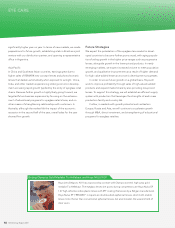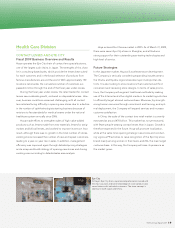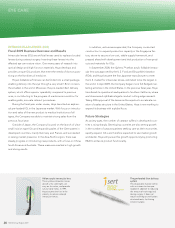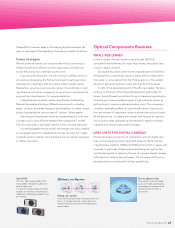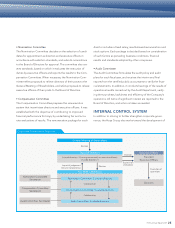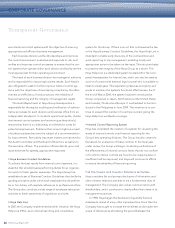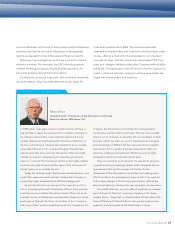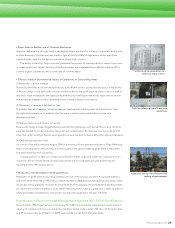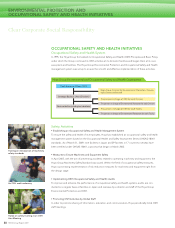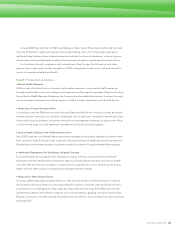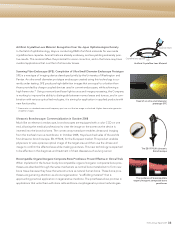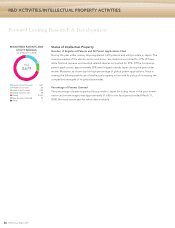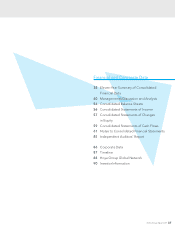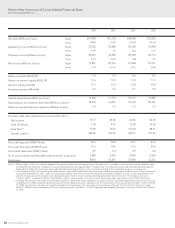Pentax 2009 Annual Report Download - page 30
Download and view the complete annual report
Please find page 30 of the 2009 Pentax annual report below. You can navigate through the pages in the report by either clicking on the pages listed below, or by using the keyword search tool below to find specific information within the annual report.
ENVIRONMENTAL PROTECTION AND
OCCUPATIONAL SAFETY AND HEALTH INITIATIVES
ENVIRONMENTAL ACTIVITIES
Environmental Management System
Hoya’s environmental protection activities got underway in 1976 with the establishment of pollution coun-
termeasure committees at each facility. In 1993, the Group drew up its Environmental Philosophy and a
set of Fundamental Environmental Principles. The next step came in 1996 with the formulation of the
Group Environmental Management Regulation, on which Hoya’s environmental protection system is
based. The Conference of the Environmental Office, the most senior body of the system and responsible
for all environmental decisions, was headed up by the Company’s chief executive officer. However, in
October 2008 the Company merged its environmental protection and occupational safety and health
systems, abolishing both the Environmental Management Regulation and the Conference of the Environ-
mental Office. Environmental protection activities are now carried out under a new system headed up by
the Hoya Group Director for Environmental Protection, Occupational Safety and Health.
Examples of Activities Aimed at Reducing Environmental Impact and Risk
• Activities to Reduce Waste Disposal Volumes and Increase Waste Recycling
(1) Reducing effluent volumes
Hoya has reduced effluent volume at the facility in Hachioji, Tokyo by separating the water from the efflu-
ent using an evaporation process and further reducing the flow of the recovered water by introducing a
volume reduction unit.
(2) Recycling plastic chip waste
In a section of the Thailand plant, the discharge methods and disposal contractors used for waste, primar-
ily plastic chip waste, were revised based on methods used in Japan, enabling the recycling of waste that
previously had been disposed of as landfill as source of energy. In implementing these measures, the
Company took particular care to comply with laws and regulations and avoid any secondary pollution
impact from harmful substances. As a result, by the end of March 2009, the section of the Thailand plant
had increased its recycling of discharged waste by about 74%, and reduced its waste discharge, including
non-plastic waste, by approximately 27% compared to the previous year.
(3) Equipment for collecting intensively waste fluid generated from lens cutting
Hoya’s facility in Koka, Shiga Prefecture switched their method of collecting waste fluid generated from
the lens polishing process from drum cans to a collection tank. Eliminating the need to transport the
drum cans also substantially reduced the risk of oil leakage.
(4) Recycling portable rechargeable batteries
As a member of the Japan Portable Rechargeable Battery Recycling Center (JBRC), a cooperative for
recycling small rechargeable batteries, Hoya promotes battery recycling activities. The Company has
installed a recycling box at the Itabashi facility in Tokyo to recycle batteries.
(5) Collecting PET bottle caps
Hoya collects PET bottle caps at the facilities as part of their environmental activities. The collected caps
are sold to recyclers and the revenues put to use to send vaccines to children in developed countries
through a nonprofit organization (NPO).
Collecting tank for waste fluid
generated from lens cutting
A Secondary battery recycling box
A PET bottle cap recycling box
Clear Corporate Social Responsibility
28 HOYA Annual Report 2009


